PEUGEOT 308 2015 Owners Manual
Manufacturer: PEUGEOT, Model Year: 2015, Model line: 308, Model: Peugeot 308 2015Pages: 344, PDF Size: 12.22 MB
Page 141 of 344
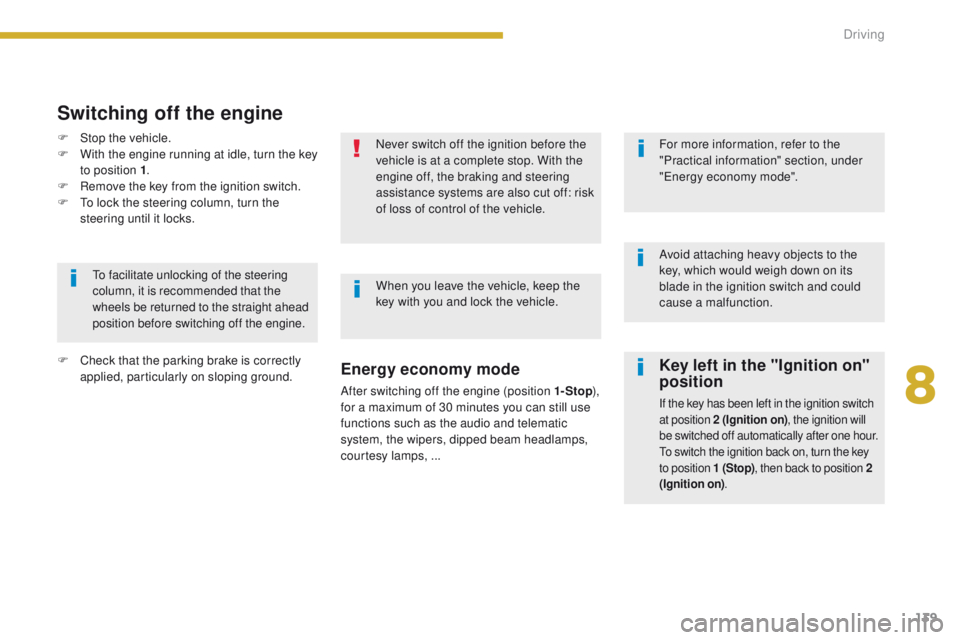
139
Key left in the "Ignition on"
position
If the key has been left in the ignition switch
at position 2 (Ignition on), the ignition will
be switched off automatically after one hour.
To switch the ignition back on, turn the key
to position 1 (Stop) , then back to position 2
(Ignition on) .
Avoid attaching heavy objects to the
key, which would weigh down on its
blade in the ignition switch and could
cause a malfunction. For more information, refer to the
"Practical information" section, under
"Energy economy mode".
Switching off the engine
Energy economy mode
After switching off the engine (position 1- Stop ),
for a maximum of 30 minutes you can still use
functions such as the audio and telematic
system, the wipers, dipped beam headlamps,
courtesy lamps, ...
To facilitate unlocking of the steering
column, it is recommended that the
wheels be returned to the straight ahead
position before switching off the engine.
F
C
heck that the parking brake is correctly
applied, particularly on sloping ground. Never switch off the ignition before the
vehicle is at a complete stop. With the
engine off, the braking and steering
assistance systems are also cut off: risk
of loss of control of the vehicle.
When you leave the vehicle, keep the
key with you and lock the vehicle.
F
S
top the vehicle.
F
W
ith the engine running at idle, turn the key
to position 1 .
F
R
emove the key from the ignition switch.
F
T
o lock the steering column, turn the
steering until it locks.
8
Driving
Page 142 of 344
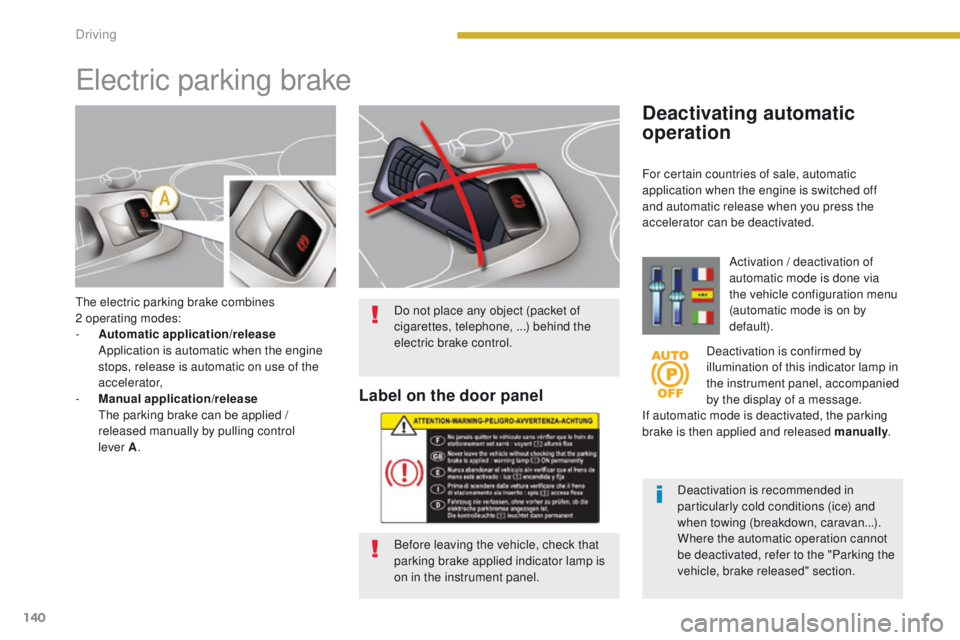
140
The electric parking brake combines
2 operating modes:
-
A
utomatic application/release
A
pplication is automatic when the engine
stops, release is automatic on use of the
accelerator,
-
M
anual application/release
T
he parking brake can be applied /
released manually by pulling control
lever
A.
Electric parking brake
Deactivating automatic
operation
Activation / deactivation of
automatic mode is done via
the vehicle configuration menu
(automatic mode is on by
default).
Deactivation is confirmed by
illumination of this indicator lamp in
the instrument panel, accompanied
by the display of a message.
If automatic mode is deactivated, the parking
brake is then applied and released manually .
Deactivation is recommended in
particularly cold conditions (ice) and
when towing (breakdown, caravan...).
Where the automatic operation cannot
be deactivated, refer to the "Parking the
vehicle, brake released" section.
Do not place any object (packet of
cigarettes, telephone, ...) behind the
electric brake control.
Label on the door panel
Before leaving the vehicle, check that
parking brake applied indicator lamp is
on in the instrument panel. For certain countries of sale, automatic
application when the engine is switched off
and automatic release when you press the
accelerator can be deactivated.
Driving
Page 143 of 344
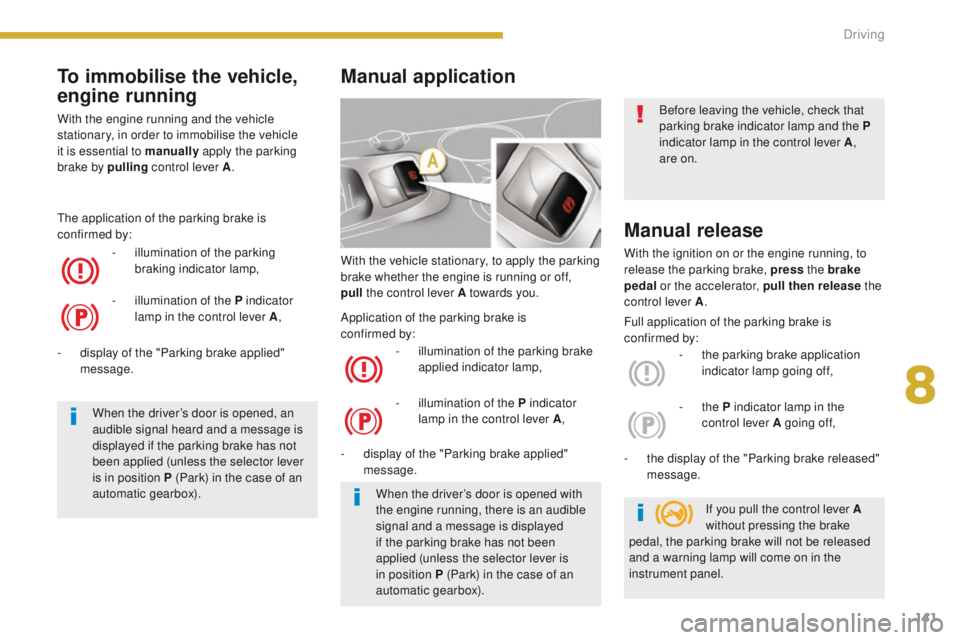
141
With the vehicle stationary, to apply the parking
brake whether the engine is running or off,
pull
the control lever A towards you.
-
i
llumination of the parking brake
applied indicator lamp,
-
d
isplay of the "Parking brake applied"
message.
Manual release
With the ignition on or the engine running, to
release the parking brake, press the brake
pedal or the accelerator, pull then release the
control lever A .
-
t
he parking brake application
indicator lamp going off,
-
t
he display of the "Parking brake released"
message.
Manual application
- illumination of the P indicator lamp in the control lever A ,-
the P indicator lamp in the
control lever A going of f,
When the driver’s door is opened with
the engine running, there is an audible
signal and a message is displayed
if the parking brake has not been
applied (unless the selector lever is
in position
P (Park) in the case of an
automatic gearbox). If you pull the control lever A
without pressing the brake
pedal, the parking brake will not be released
and a warning lamp will come on in the
instrument panel. Before leaving the vehicle, check that
parking brake indicator lamp and the
P
indicator lamp in the control lever A ,
are on.
Full application of the parking brake is
confirmed by:
Application of the parking brake is
confirmed
by:
To immobilise the vehicle,
engine running
With the engine running and the vehicle
stationary, in order to immobilise the vehicle
it is essential to manually
apply the parking
brake by pulling
control lever A.
-
i
llumination of the parking
braking indicator lamp,
The application of the parking brake is
confirmed by:
-
i
llumination of the P indicator
lamp in the control lever A ,
When the driver’s door is opened, an
audible signal heard and a message is
displayed if the parking brake has not
been applied (unless the selector lever
is in position P (Park) in the case of an
automatic gearbox).
-
d
isplay of the "Parking brake applied"
message.
8
Driving
Page 144 of 344
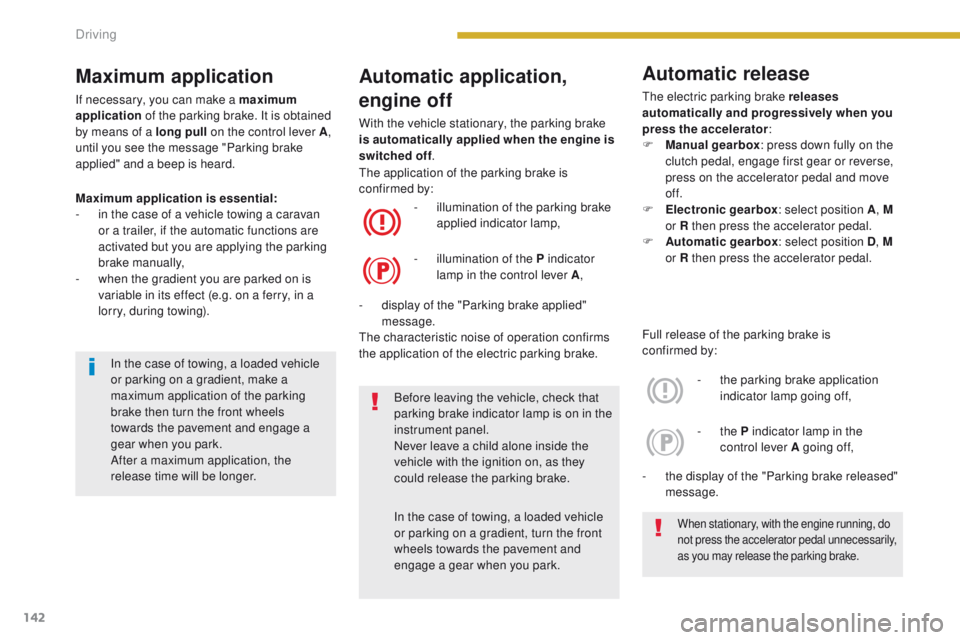
142
Automatic application,
engine off
With the vehicle stationary, the parking brake
is automatically applied when the engine is
switched off.
Maximum application is essential:
-
i
n the case of a vehicle towing a caravan
or a trailer, if the automatic functions are
activated but you are applying the parking
brake manually,
-
w
hen the gradient you are parked on is
variable in its effect (e.g. on a ferry, in a
lorry, during towing). -
i
llumination of the parking brake
applied indicator lamp,
-
d
isplay of the "Parking brake applied"
message.
The characteristic noise of operation confirms
the application of the electric parking brake. The application of the parking brake is
confirmed by:
-
i
llumination of the P indicator
lamp in the control lever A ,
Before leaving the vehicle, check that
parking brake indicator lamp is on in the
instrument panel.
Never leave a child alone inside the
vehicle with the ignition on, as they
could release the parking brake.
In the case of towing, a loaded vehicle
or parking on a gradient, turn the front
wheels towards the pavement and
engage a gear when you park.
When stationary, with the engine running, do
not press the accelerator pedal unnecessarily,
as you may release the parking brake.
In the case of towing, a loaded vehicle
or parking on a gradient, make a
maximum application of the parking
brake then turn the front wheels
towards the pavement and engage a
gear when you park.
After a maximum application, the
release time will be longer.
Maximum application
If necessary, you can make a maximum
application of the parking brake. It is obtained
by means of a long pull on the control lever
A,
until you see the message "Parking brake
applied" and a beep is heard.
Full release of the parking brake is
confirmed
by:
-
t
he parking brake application
indicator lamp going off,
-
t
he display of the "Parking brake released"
message. -
the P indicator lamp in the
control lever A going of f,
Automatic release
The electric parking brake releases
automatically and progressively when you
press the accelerator :
F
M
anual gearbox : press down fully on the
clutch pedal, engage first gear or reverse,
press on the accelerator pedal and move
of f.
F
E
lectronic gearbox : select position A, M
or R then press the accelerator pedal.
F
A
utomatic gearbox : select position D, M
or R then press the accelerator pedal.
Driving
Page 145 of 344
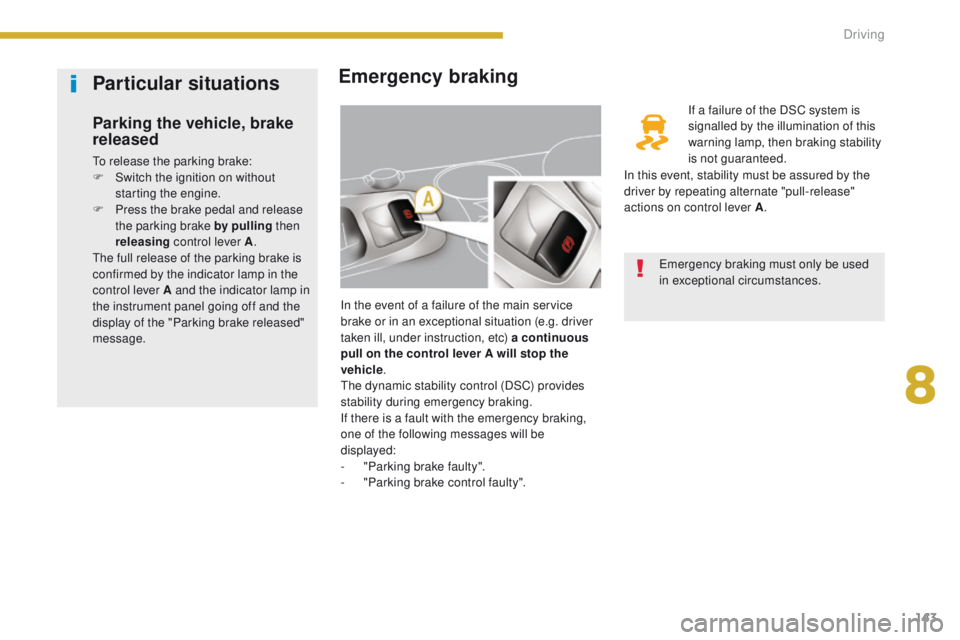
143
Emergency braking
In the event of a failure of the main service
brake or in an exceptional situation (e.g. driver
taken ill, under instruction, etc) a continuous
pull on the control lever A will stop the
vehicle .
The dynamic stability control (DSC) provides
stability during emergency braking.
If there is a fault with the emergency braking,
one of the following messages will be
displayed:
-
"
Parking brake faulty".
-
"
Parking brake control faulty". If a failure of the DSC system is
signalled by the illumination of this
warning lamp, then braking stability
is not guaranteed.
Emergency braking must only be used
in exceptional circumstances.
Particular situations
Parking the vehicle, brake
released
To release the parking brake:
F S witch the ignition on without
starting the engine.
F
P
ress the brake pedal and release
the parking brake by pulling then
releasing control lever A .
The full release of the parking brake is
confirmed by the indicator lamp in the
control lever A and the indicator lamp in
the instrument panel going off and the
display of the "Parking brake released"
message. In this event, stability must be assured by the
driver by repeating alternate "pull-release"
actions on control lever A
.
8
Driving
Page 146 of 344
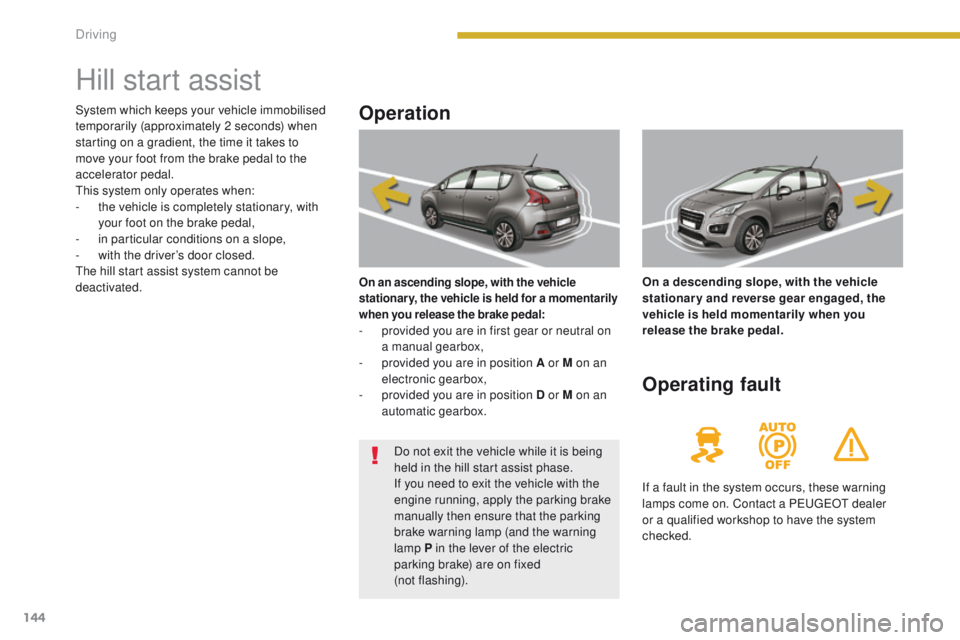
144
Hill start assist
Operation
On an ascending slope, with the vehicle
stationary, the vehicle is held for a momentarily
when you release the brake pedal:
- provided you are in first gear or neutral on a manual gearbox,
-
p
rovided you are in position A or M on an
electronic gearbox,
-
p
rovided you are in position D or M on an
automatic gearbox. On a descending slope, with the vehicle
stationary and reverse gear engaged, the
vehicle is held momentarily when you
release the brake pedal.
Operating fault
If a fault in the system occurs, these warning
lamps come on. Contact a PEUGEOT dealer
or a qualified workshop to have the system
checked.
System which keeps your vehicle immobilised
temporarily (approximately 2 seconds) when
starting on a gradient, the time it takes to
move your foot from the brake pedal to the
accelerator pedal.
This system only operates when:
-
t
he vehicle is completely stationary, with
your foot on the brake pedal,
-
i
n particular conditions on a slope,
-
w
ith the driver’s door closed.
The hill start assist system cannot be
deactivated.
Do not exit the vehicle while it is being
held in the hill start assist phase.
If you need to exit the vehicle with the
engine running, apply the parking brake
manually then ensure that the parking
brake warning lamp (and the warning
lamp P in the lever of the electric
parking brake) are on fixed
(not flashing).
Driving
Page 147 of 344
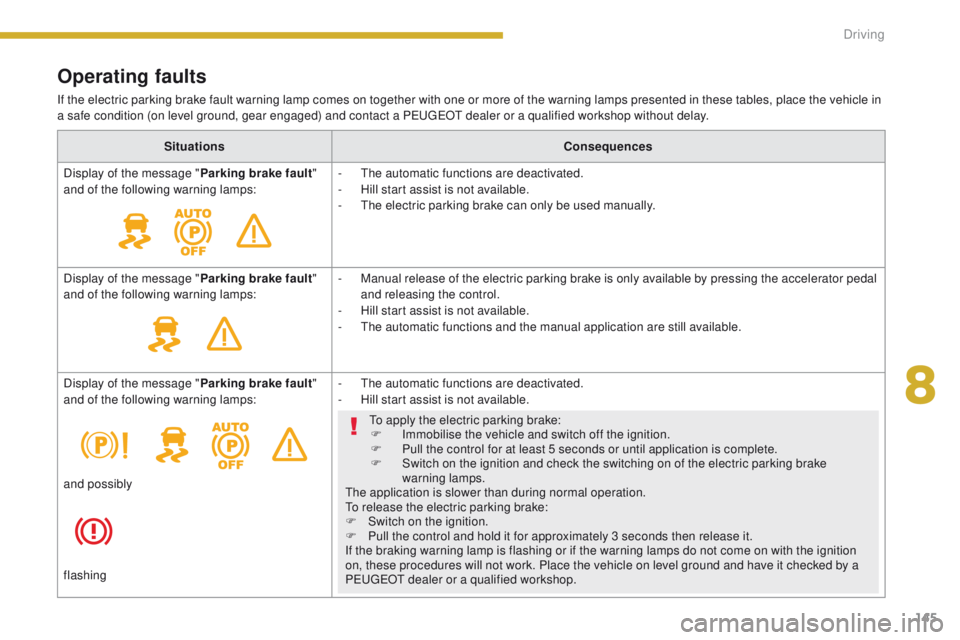
145
Operating faults
If the electric parking brake fault warning lamp comes on together with one or more of the warning lamps presented in these tables, place the vehicle in
a safe condition (on level ground, gear engaged) and contact a PEUGEOT dealer or a qualified workshop without delay.Situations Consequences
Display of the message " Parking brake fault"
and of the following warning lamps: -
T
he automatic functions are deactivated.
-
H
ill start assist is not available.
-
T
he electric parking brake can only be used manually.
Display of the message " Parking brake fault"
and of the following warning lamps: -
M
anual release of the electric parking brake is only available by pressing the accelerator pedal
and releasing the control.
-
H
ill start assist is not available.
-
T
he automatic functions and the manual application are still available.
Display of the message " Parking brake fault"
and of the following warning lamps: -
T
he automatic functions are deactivated.
-
H
ill start assist is not available.
To apply the electric parking brake: F
I
mmobilise the vehicle and switch off the ignition.
F
P
ull the control for at least 5 seconds or until application is complete.
F
S
witch on the ignition and check the switching on of the electric parking brake
warning lamps.
The application is slower than during normal operation.
To release the electric parking brake:
F
S
witch on the ignition.
F
P
ull the control and hold it for approximately 3 seconds then release it.
If the braking warning lamp is flashing or if the warning lamps do not come on with the ignition
on, these procedures will not work. Place the vehicle on level ground and have it checked by a
PEUGEOT dealer or a qualified workshop.
and possibly
flashing
8
Driving
Page 148 of 344
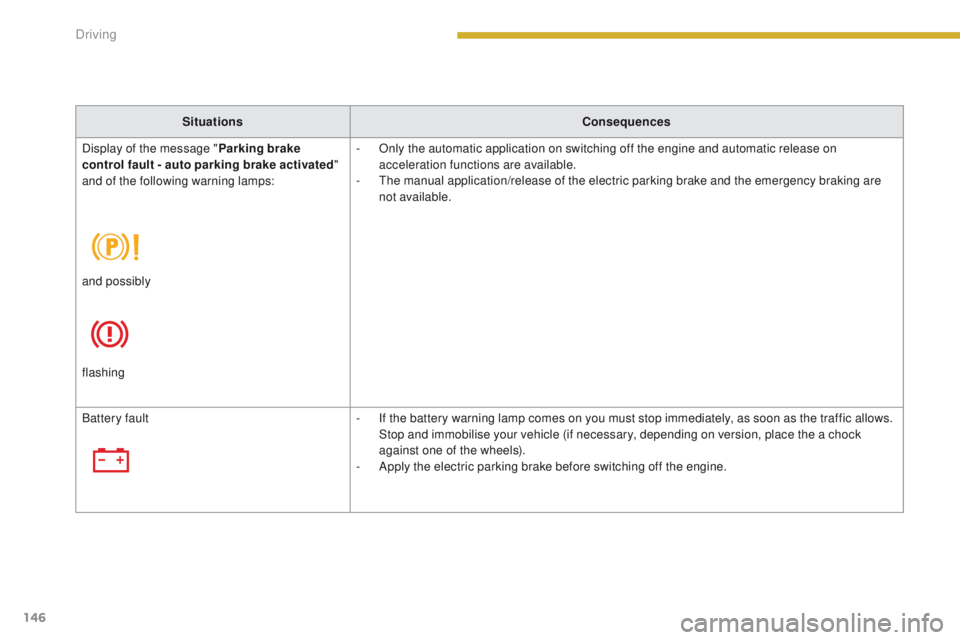
146
SituationsConsequences
Display of the message " Parking brake
control fault - auto parking brake activated "
and of the following warning lamps: -
O
nly the automatic application on switching off the engine and automatic release on
acceleration functions are available.
-
T
he manual application/release of the electric parking brake and the emergency braking are
not available.
and possibly
flashing
Battery fault -
I
f the battery warning lamp comes on you must stop immediately, as soon as the traffic allows.
Stop and immobilise your vehicle (if necessary, depending on version, place the a chock
against one of the wheels).
-
A
pply the electric parking brake before switching off the engine.
Driving
Page 149 of 344
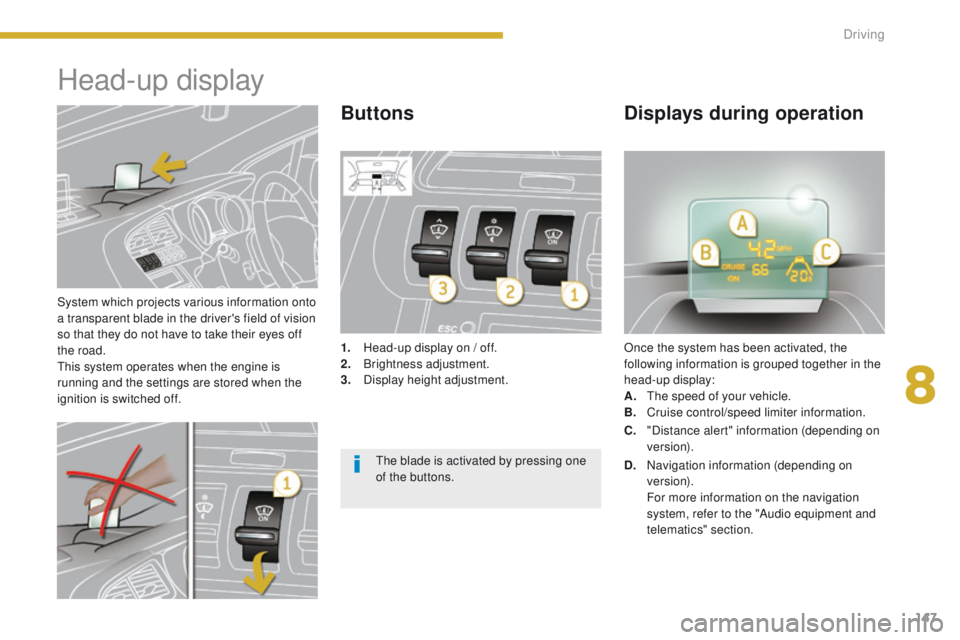
147
System which projects various information onto
a transparent blade in the driver's field of vision
so that they do not have to take their eyes off
the road.
This system operates when the engine is
running and the settings are stored when the
ignition is switched off.
Head-up display
1. Head-up display on / off.
2. Br ightness adjustment.
3.
D
isplay height adjustment. Once the system has been activated, the
following information is grouped together in the
head-up display:
A.
T
he speed of your vehicle.
B.
C
ruise control/speed limiter information.
ButtonsDisplays during operation
C. "Distance alert" information (depending on
ve r s i o n).
The blade is activated by pressing one
of the buttons. D.
N
avigation information (depending on
ve r s i o n).
F
or more information on the navigation
system, refer to the "Audio equipment and
telematics" section.
8
Driving
Page 150 of 344
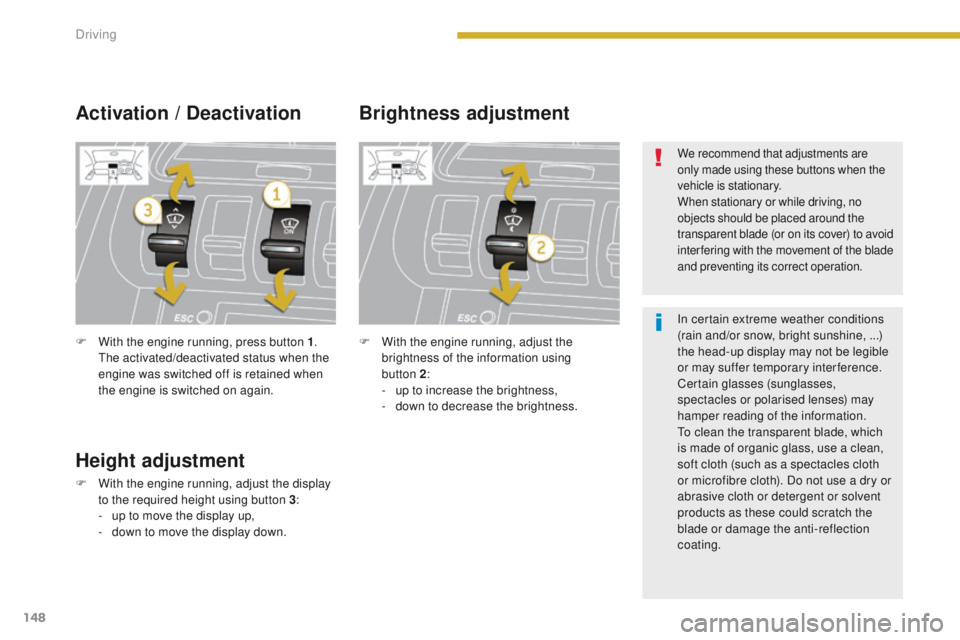
148
F With the engine running, press button 1.
The activated/deactivated status when the
engine was switched off is retained when
the engine is switched on again. F
W ith the engine running, adjust the
brightness of the information using
button
2:
-
u
p to increase the brightness,
-
d
own to decrease the brightness.
Activation / Deactivation Brightness adjustment
Height adjustment
F With the engine running, adjust the display to the required height using button 3 :
-
u
p to move the display up,
-
d
own to move the display down.
We recommend that adjustments are
only made using these buttons when the
vehicle is stationary.
When stationary or while driving, no
objects should be placed around the
transparent blade (or on its cover) to avoid
inter fering with the movement of the blade
and preventing its correct operation.
In certain extreme weather conditions
(rain and/or snow, bright sunshine, ...)
the head-up display may not be legible
or may suffer temporary interference.
Certain glasses (sunglasses,
spectacles or polarised lenses) may
hamper reading of the information.
To clean the transparent blade, which
is made of organic glass, use a clean,
soft cloth (such as a spectacles cloth
or microfibre cloth). Do not use a dry or
abrasive cloth or detergent or solvent
products as these could scratch the
blade or damage the anti-reflection
coating.
Driving